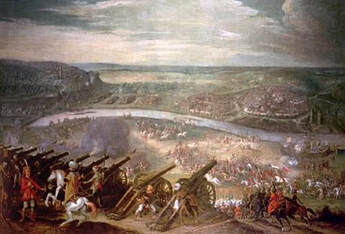 To listen to the audio, click here. To view the video, click here. To view the PowerPoint, as presented at the Reformation Society, click here. This year marks the 455th anniversary of a most dramatic defeat of Islamic Jihad against Europe. Faced by a new threat of Islamic invasions, Europe needs to learn afresh the lessons of the Great Siege of Malta which must rate as one of the greatest episodes of courage and fortitude against all odds. The Turkish Threat In 1565 Islam was threatening all of Europe. The Ottoman Turkish Empire had conquered the entire Middle East, sacking what was once the greatest city in the world, Constantinople (now renamed Istanbul), massacring the Christian population. In 1526, the Turks had unsuccessfully besieged Vienna, in the very heart of Europe. 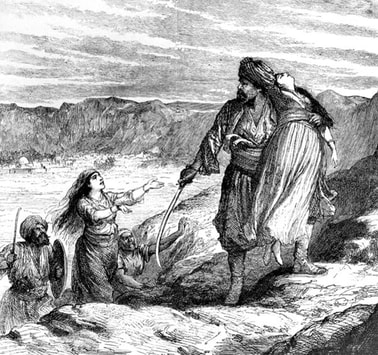 Slave Raids on Europe Muslim slave raiders were depopulating whole villages, attacking coastal towns of Italy, France, Spain, Portugal, England, Wales and Ireland and even seizing white slaves from as far away as Iceland. Ultimately over 1.1 million Christian Europeans were kidnapped and enslaved in North Africa by Muslim pirates between 1500 and 1800. The Last Crusaders One thorn in the side of the aggressive expansionism of the Ottoman Empire was the Christian Island of Malta. Malta was the headquarters of the last crusaders; the Knights Hospitaller, also known as the Order of St. John of Jerusalem. The Knights of St. John had proven to be the most tenacious enemies of Islamic Jihad. They were the last knights to leave the Holy Land. From the Island of Rhodes, they had raided Islamic shipping, setting many Christian captives free from Islamic slavery. After enduring severe sieges of Rhodes, their position in the eastern Mediterranean became indefensible and they sailed away, leaving that island to the Muslims. A New Base of Operations The Emperor of the Holy Roman Empire, Charles V, offered the Knights of St. John the Island of Malta as a new base for their operations. On 26 October 1530, the knights sailed into Malta’s Grand Harbour and soon turned this strategic island into a Naval Base from which they intercepted many Muslim slave raiders, endangering the lucrative Muslim piracy and slavery racket. 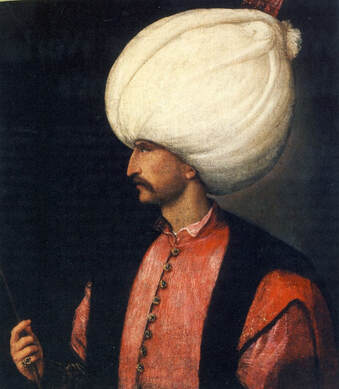 Suleiman Determines to Destroy the Knights of Malta As the Knights of St. John continued to interdict and harass the Turkish piracy routes, "Suleiman the Magnificent – Vice Regent of God on earth, Lord of the lords of East and West, and possessor of men’s necks, King of believers and unbelievers … majestic Caesar, etc. etc." mobilised the largest armada yet seen with 193 ships, 40,000 fighting men, including over 6,300 of the elite Janissaries ("the invincible ones"). Their objective: to wipe the Knights of St. John off the face of the earth and capture the strategic island of Malta for Islam: "So long as Malta remains in the hands of the knights, so long will relief from Constantinople to Tripoli run the danger of being taken or destroyed… this cursed rock is like a barrier interposed between us and your possessions…" The Siege of 1551 This was not the first time that the Turks had attempted to seize Malta. In 1551 the Corsair Turgot Reis had invaded the Island with a force of over 10,000 fighting men. As this attempt failed, Turgot withdrew and bombarded the neighbouring Island of Gozo. After the population surrendered and opened their gates of their city, the Muslims looted the town and enslaved virtually the entire population of 5,000 people. The Ongoing War Throughout the years, the Guerre de Course (running battle), between the Muslim slave raiding pirates and the Knights of St. John continued unabated. 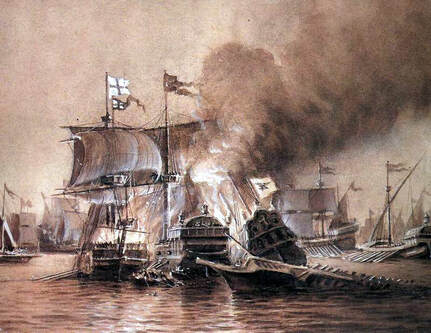 The Disaster of Djerba In May 1560, the Ottoman victory in the naval battle of Djerba captured or sunk about half the vast Spanish naval expedition, which sought to evict the Corsair pirates from Tripoli. This disaster marked the high point of Ottoman Turkish domination of the Mediterranean Sea. Preparing for Invasion As a result of this failed siege of 1551, the Knights of St. John strengthened Fort St Angelo at the tip of Birgu as well as constructing of two new forts: Fort St. Michael (at Senglea) and Fort St. Elmo (on Mount Sciberras). All three of these forts proved crucial during the great siege of 1565. The Grand Master of the Order of St. John, Jean de la Valette, began vigorous preparations to enable Malta to survive an extended siege. As his espionage network informed him of the imminent invasion, De la Valette set about accumulating stores, ammunition, strengthening fortifications, recruiting further fighting men and recalling all knights to Malta. The Islamic Invasion Force The official historian of the Order, Giacomo Bosio, recorded that the Turkish fleet consisted of 193 vessels including 131 galleys, 7 galliots, 11 large merchant ships (one of which alone held 600 armed men, 6,000 barrels of gun powder and 1,300 rounds of cannon ball.) Balbi di Correggio, in his famous Siege Diary, records that the Turkish invading force included: 6,300 Janissaries, over 6,000 spahis (cavalry), 4,000 "religious fanatics", 2,500 spahis from Rouania, 500 spahis from Karamania, 6,000 other volunteers, various corsairs from Tripoli and Algiers totalling over 48,000 fighting men in all. 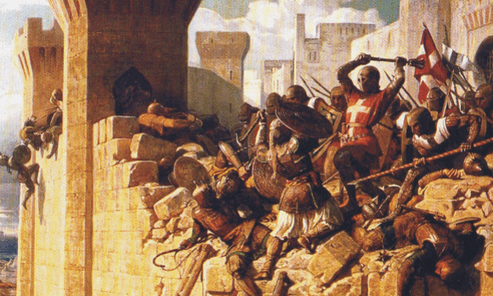 The Defenders On the Christian side, there were less than 700 Knights of St. John, 400 Spanish soldiers, 800 Italian soldiers, 200 Greek and Sicilian soldiers, approximately 3,000 soldiers drawn from the Maltese population, and along with other civilians who were given weapons, a total force of less than 9,000 men. De la Valette The Grand Master of the Order of St. John, Jean de la Valette, was 71 years old. He had been a Knight of St. John, for 18 years old. He was a veteran of the siege of Rhodes of 1522. De la Valette had survived a year as a galley slave, rowing up to 20 hours a day in a Muslim galley. The Cross and the Crescent Valette challenged his knights: "It is the great battle of the Cross and the Quran which is now to be fought. A formidable army of infidels are on the point of invading our Island. We, for our part, are the chosen soldiers of the Cross, and if Heaven requires the sacrifice of our lives, there can be no better occasion than this. Let us hasten then, my brothers, to the sacred altar. There we will renew our vows and retain by our Faith in the sacred sacraments, that contempt for death which alone can render us invincible." 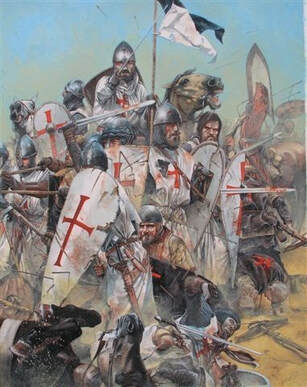 The Knights of St. John When the knights left the church, they were filled with enthusiastic joy. It was reported that after the service every kind of weakness disappeared. "All divisions between them and all private animosities ceased." The Knights of the Order of St. John of Jerusalem were devout, aristocratic and war-like. They boasted the bluest of blood among their members. The military monks had developed an efficient security service providing armed escorts for Christian pilgrims throughout the dangerous Holy Land. After the success of the First Crusade they became a Military Order in 1113. Young aristocrats from Spain, Portugal, England, France, Germany and Italy enthusiastically joined the Knights of St. John. The knights became recognised as the very frontline of the battle for Christendom, a bulwark to keep Europe safe from Islamic Jihadists. The Knights of St. John were recognised as the toughest soldiers in Christendom. The Siege of Rhodes In 1522, 7,000 knights and soldiers on the island of Rhodes resisted over 90,000 of the Sultan's forces for six months. Only when all supplies were exhausted and no possibility of continuing the fight remained, did the Knights of St. John board their ships and withdraw. The Siege of Malta 1565 As the sun rose on 18 May, 1565, the horizon filled with white sails emblazoned with the Sultan's Red Crescent. The Great Siege of Malta had begun. The invaders were supremely confident they would be able to overwhelm and subjugate the small band of knights on the island of Malta. 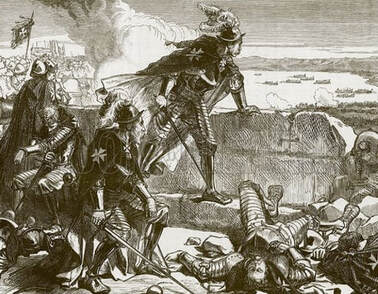 St. Elmo Their first target was the small Fort of St. Elmo, which dominated the entrance to the Grand Harbour. A mere 100 knights and 500 soldiers held Fort St. Elmo. De la Valette had ordered them to fight to the last man. The length of their survival would determine the outcome of the whole campaign. The Turks had estimated that they would need just three days to bombard St. Elmo into submission. Yet the garrison of St. Elmo held on through an incredible 35 days of constant bombardment and waves of assault. A Battle for Europe All of Europe prayed fervently realising what was at stake. As Queen Elizabeth of England declared: "If the Turks should prevail against the Isle of Malta, it is uncertain what further peril might follow to the rest of Christendom." Artillery Barrage Mustapha Pasha ordered the huge siege guns to be dragged to Mount Sciberras. Two 60-pound culverins, ten 80 pounders and an enormous basilisk firing a solid 160-pound shot were brought for the attack on St. Elmo. After a week of preparation and bombardment by such heavy artillery, the sandstone and lime blocks composing the Fort of St. Elmo had begun to crumble. The Turks relentlessly pounded away at the small fort. Counter Attack! After the first night of bombardment, the besieged knights made a sortie, stealthfully lowering their drawbridge and captured the closest enemy trench. Mustapha commanded "Janissaries forward!" As the Janissaries stormed the trenches they were cut down by the cannon of St. Elmo. 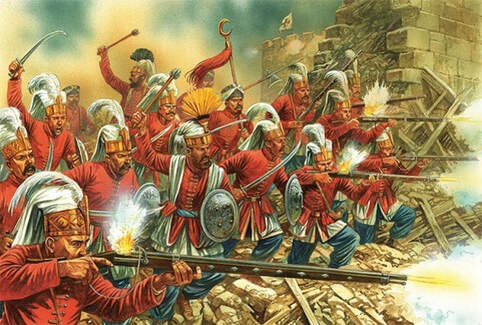 The Drawn Sword of Islam The arrival of Drajut, known amongst his men as "the drawn sword of Islam" and "the scourge of the Christians", encouraged the Turkish forces. He brought another 1,500 of his elite warriors. Drajut noticed what Mustapha had missed: the strength of St. Elmo was the re-supplies they received each night from St. Angelo. As the artillery bombardment of St. Elmo doubled in intensity, their defenders tried to erect counter walls behind the crumbling outer walls. Abandoned and Alone At this time, word reached de la Valette that the relief hoped for, from nearby Sicily, had been seriously delayed. Valette read the dispatch to his Council and declared: "We now know that we cannot look to others for our deliverance! It is only upon God and our own swords that we must rely. Yet this is no reason to be disheartened. Rather the opposite. For it is better to know the truth of one’s situation than be deceived by false hopes. Our Faith and the honour of our Order are in our own hands. We shall not fail!" Repulsing the Attackers On 3rd June a new battery erected on Tigne Point opened up a steady fire on St. Elmo. Then the Janissaries attacked. They swarmed over the reduced Ravelin, wiping out the exhausted survivors. Then they stormed towards the gates of St. Elmo. The cannon protecting the portcullis opened fire on the advancing ranks of Janissaries. The defenders of St. Elmo used burning hoops to set ablaze the white robed Turks. Arquebus shot and blocks of stone met the Muslims and cauldrons of boiling pitch set many of the invaders aflame. 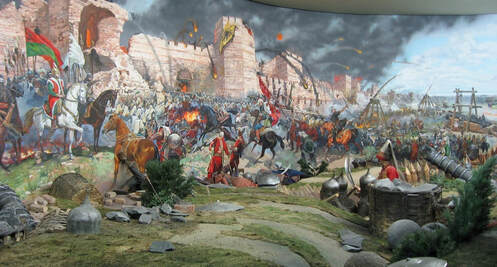 Relentless From dawn until noon, the battle raged around the bridge and walls of St. Elmo. Yet the flag of the Knights of St. John still waved above the ramparts engulfed in flames and smoke. Wave after wave of Janissaries was unleashed upon St. Elmo. By the time Mustapha called off his troops over 2,000 of the Janissaries lay dead, as opposed to 10 knights and 70 soldiers, who had died defending St. Elmo that day. Under Fire A report from St. Elmo sent that night declared: "Pounded by hostile cannon… in arms always, and prepared for combat, by day exposed to the burning sun, and by night to the cold and damp, privation of all kinds, from the blast of gunpowder, smoke, dust, wildfire, iron and stones, musketry, explosions of enormous batteries; insufficient nutriment, so disfigured that we hardly know each other anymore, ashamed of retiring for wounds not manifestly quite dangerous, or almost mortal, those with the smaller bones dislocated, or shattered, and livid faces bruised with frightful sores, or extremely lame and limping woefully, those miserably bandaged around the head, arms in slings, strange contortions, such figures were frequent and nearly general…" The Turkish gunfire was so heavy that it seemed as if "they were determined to reduce the fortress to powder." Bombarded On Thursday, another Turkish attack was blasted by a hail of bullets and incendiary weapons. Yet the defenders came under such sustained fire that they could barely show themselves above the battlements. When the commander suggested that the fortress be evacuated and burned to the ground, Valette reminded them: “We swore obedience when we joined the Order. We swore also on the vows of Chivalry that our lives would be sacrificed for the Faith whenever, and wherever, the call ought come. Our brethren in St. Elmo must now accept that sacrifice.” 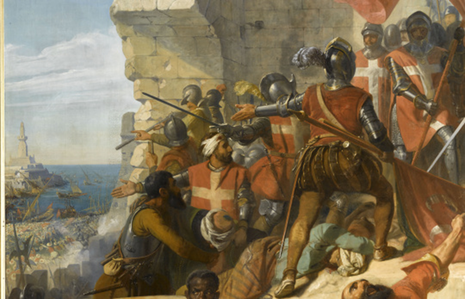 Honour and Chivalry The knights sent a further message urging: "Do not send any further reinforcements since they will be no more than dead men." They requested permission to storm the enemy and die honourably in battle, rather than remaining pounded behind the walls. Valette responded: "The laws of Honour cannot necessarily be satisfied by throwing away one’s life when it seems convenient. A soldier's duty is to obey. You will tell your comrades' that they are to stay at their posts. They are to remain there, and they are not to sally forth." Reinforcements La Valette sent another 15 knights and almost 100 soldiers to strengthen the garrison at St. Elmo. The Ottoman's stormed the fort repeatedly and were repulsed time and again. The first great night attack of the siege took place on 10 June. When dawn broke, over 1,500 of the Sultan's troops lay dead, or dying, in no-mans-land between the ravilin and the fort. St. Elmo’s’ losses that night totalled 60. No Surrender The Turkish Commander-in-Chief offered the Christians that they might retire unmolested. Each one resolved to die where they stood and to give no quarter. On the night of 15 June, the whole Turkish fleet ringed the fort and 4,000 guns opened up on St. Elmo. Then the Iayalars, the fanatical corp of Jihadists on drugs, launched a frenzied attack. They were followed by a hoard of Dervishes, then the Janissaries. Each attack was decimated and sent fleeing by the ferocious defence of the knights at St. Elmo. Another 1,000 of the Turks had died that day. 150 of the garrison of St. Elmo perished. 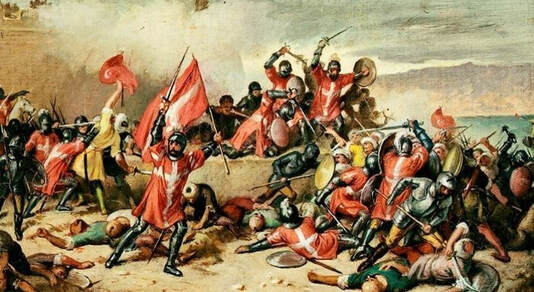 Volunteers for St. Elmo On the 18 June, La Valette called for more volunteers to reinforce St. Elmo. 30 knights and another 300 soldiers came forward and rowed across the harbour to the beleaguered and bombarded garrison of St. Elmo. On that same day, Drajut was mortally wounded by cannon shot. As "the drawn sword of Islam" was carried back to his tent, morale amongst the invading Turks was seriously weakened. Repulsed As St. Elmo was pummelled by concentrated bombardment, it seemed incredible that anything could exist in that smoking ruin. As Janissaries breached the walls, Chevalier de Montserrat, directed cannon against the centre of the Janissary attack and saved the day. That day St. Elmo lost 200 men and the Turks over 2,000. Defiance At dawn 23 June, the Ottoman galleys surrounded the ruined fort and unleashed more death and destruction upon the valiant defenders of St. Elmo. Less than 100 remained. They sang Hymns, prayed, defiantly tolled their Chapel bell and prepared to meet the Lord Jesus. Those who could no longer stand were seated in chairs, fully armed. Incredibly they held out for yet another hour. As Mustapha Pasha carried the banner of Sultan Suleiman to replace the flag of St. John at St. Elmo’s ruins, he gazed at the massive Fort St. Angelo across the bay and cried: "Allah! If so small a son has cost us so dear, what price shall we have to pay for so large a father?" The 35 days of ferocious courage of the defenders of St. Elmo had cost the invaders precious time and over 9,000 of their best troops. 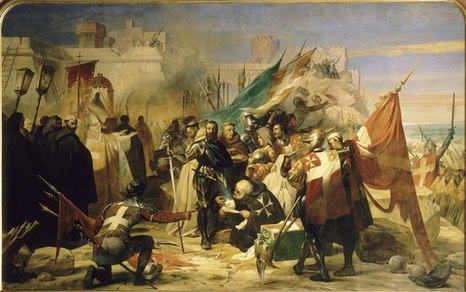 Crucifixes and Cannonballs Mustapha Pasha ordered the bodies of the knights to be decapitated. Their heads were placed on stakes and their corpses were nailed to crosses to be floated across the harbour. As the headless bodies of crucified knights washed up at the base of Fort St. Angelo, La Valette ordered their Turkish prisoners to be executed and their heads to be used as cannon balls to bombard the Turks. The message was clear: the knights would fight to the very death. No quarter would be given and none would be received. Relief The morale of the defenders of Malta was lifted when 4 galleys from Sicily managed to evade the Turkish blockade and land a small relief force of 42 knights and 700 militia. Bombardment Siege guns were transported to the heights of Corradino to begin the bombardment of Forts St. Angelo and St. Michael and the villages of Birgu and Senglea. 70 Cannon from Mount Sciberras, Gallows point, Tigne Point and Mount Salvatore and from the heights of Corradino, opened up a heavy crossfire on St. Angelo and St. Michael and on the villages of Birgu and Senglea. 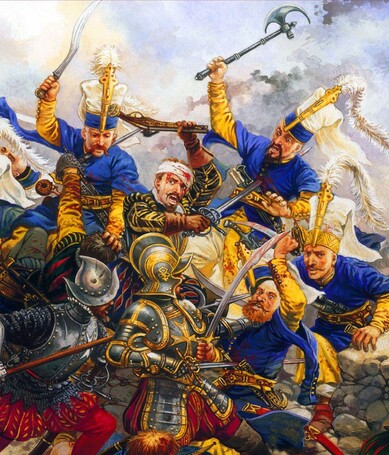 Tidal Waves of Turks On the morning of 15 July, Mustapha ordered the first major assault from both land and sea. The Algerian troops stormed the walls of St. Michael from the landward side, while the Turks landed troops to storm the seaward walls. The Algerians came on with a wild screaming rush. The Christians counter attacked and turned the tide of battle. Sea Assault As Muslim invaders fled, Mustapha sent in his masterstroke: 1,000 of his elite Janissaries, aboard 10 large boats, to land at the northern wall while the Christian defenders were preoccupied defending the southern wall. What Mustapha did not know was that Valette had positioned a battery of artillery at the base of St. Angelo, to counter just such an eventuality. Chevalier de Guiral who commanded the 5-gun battery could scarcely believe his eyes as he saw the Janissaries sailing towards the muzzles of his guns. Repulsing the Aggressors At the ideal target range, he ordered his men to open fire. 9 of the 10 boats were sunk and 800 Janissaries disappeared into the water. Only the 10th boat managed to survive and flee back across the harbour. The few Janissaries who managed to make it to land received "St. Elmos pay" (no mercy). The knights opened their gates and charged the Muslims sending them fleeing. 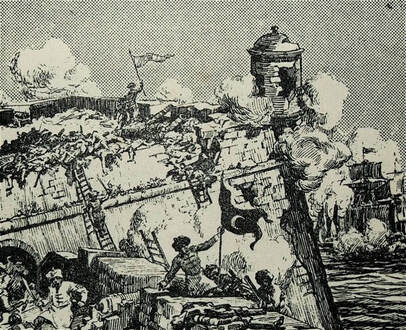 Incessant Bombardment Following the humiliation of 15 July, Mustapha adopted a more cautious approach, depending upon his artillery to reduce the walls and undermine the morale of the defenders by incessant bombardment. From North and South, from East and West, the Christian fortresses came under withering and sustained artillery barrage. The Turks gave the besieged no respite. The bombardment continued all day and night, throughout the last week of July. At dawn of 2 August, the Turks advanced while all their cannon thundered at once. People in Sicily, over 100 km away, could hear the cannon fire. It was the heaviest bombardment of the siege and it seemed impossible that any man could live through the sustained fire, let alone be in any state to fight, in the crumbling ruins of the forts. Steadfast From every ridge and slope, Muslims swarmed forward like a tidal wave against the garrisons. Yet attack after attack was repulsed and Mustapha was once again forced to concede defeat. As his exhausted and decimated assault troops withdrew, Mustapha decided to subject the Christians to a further 5 days continuous bombardment before attempting the next assault. In all, over 130,000 cannon balls were fired from the Turkish guns against the Christian defenders on Malta. Throughout the siege men, women and children worked alongside the soldiers to rebuild the walls, repair the defences and prepare bombs and ammunition. Slaughtered On 7 August, the Islamic assault was renewed. Like a tsunami, the enemy rushed upon Birgu and Senglea simultaneously. Yet as they swept over the ditch half filled with rubble from the walls, and through the breaches of walls blasted by continuous cannon fire, they were confronted by another interior wall! The troops who had poured in through the outer breaches now came under a withering fire from the garrison. Unable to turn back because of the weight of their numbers pressing behind them, they were trapped in a narrow killing ground where they were slaughtered in their hundreds. 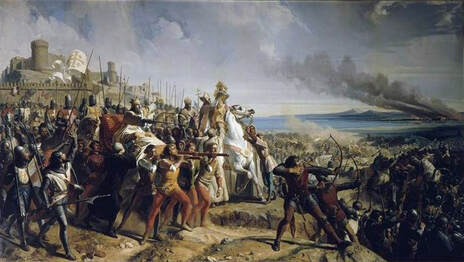 As Bold as Lions Then the Christian defenders leapt from their entrenchments and stormed the faltering attackers. The Muslims turned and fled, slipping and sliding over the blood of their comrades and tripping over the mounds of dead bodies as they fled from the fight. Attacking the Attackers Yet, while the Turkish attack on St. Angelo was routed, their assault on St. Michael was succeeding. Turkish flags began to appear along the ramparts. It was at this point that the governor of Mdina, the capital of Malta, launched his cavalry force against the lightly guarded Turkish headquarters. The Christians overwhelmed the sentries, killing every man that they could find, capturing, or destroying, a huge store of provisions and ammunition. As a messenger galloped up to Mustapha to inform him that a large Christian force had swarmed over their camp, Mustapha feared the worst. He assumed that this was the relief force from Sicily! Mustapha ordered a general retreat. In this way Fort St. Michael was saved. Isolated However, there was no relief force. Valette called his Council together that night and informed his men: "I will tell you now openly, my brethren, that there is no hope to be looked for, except in the succour of Almighty God - the only true Help. He who has looked after us until now will not forsake us, nor will He deliver us into the hands of the enemies of the holy Faith. We are soldiers, and we shall die fighting. If, by any evil chance, the enemy should prevail, we can expect no better treatment than our brethren who were in St. Elmo… Let no man think that there can be any question of receiving honourable treatment, or escaping with his life. If we are beaten, we shall all be killed. It would be better to die in battle than terribly and ignominiously at the hands of the Muslims." 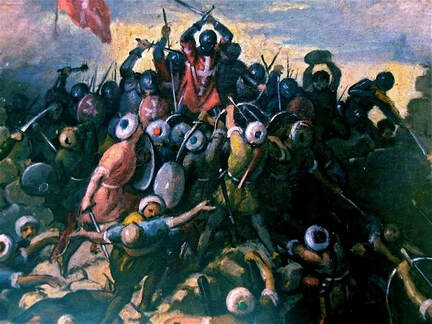 Determination There was to be no more talk of relief forces. "With the greatest devotion, with the firmest hope and faith that they would be received into glory, they resolved to die for their cause." Undermined The Muslims began to tunnel under the defences to plant mines. With a tremendous explosion the bastion of Castile in Senglea collapsed. As the survivors staggered back in confusion, waves of Turks swarmed through the breach. Valette seized a pike and boldly ran from his command post towards the breach. Seeing the Grand Master running to the point of danger, all the knights and soldiers joined him in turning back the tide of Islamic advance. Resolute A grenade exploded near Valette and knights rushed to defend him. "Withdraw, Sire, to a place of safety!" Valette refused. "The enemy is already in retreat!" Valette continued to advance against the enemy declaring: "As long as their banners still wave in the wind, I will not withdraw." The knights and soldiers surged forward with incredible tenacity until, within a few minutes, the Turks were routed and fleeing in disarray. There was no darkness that night as gunfire lit up the sky and cannon pounded the walls. Yet the Christians stood firm and by dawn the Turks withdrew in defeat. 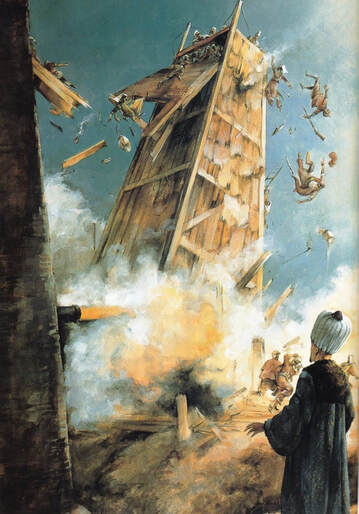 The Tower Now Mustapha unleashed his siege tower, which was higher than the walls. Janissaries used its platform to fire upon the defenders of Birgu. Valette had his workmen burrow a hole in the base of the wall facing the tower. They wheeled out a large cannon which fired 2 large cannon balls fastened together by a chain. The chainshot sliced through the structure, causing it to collapse, spilling Turks, incendiary grenades and fuel which set the giant tower ablaze. Seizing the Initiative On 20 August, the Turks brought up another larger siege engine reinforced at the base with earth and stone work. The Knights of St. John stormed the tower in a surprise sortie and swept up the laddered floors eliminating the Janissaries in a matter of minutes. They then turned this siege engine into an additional fighting platform to defend their walls. The two Turkish cannon on it poured fire into the dismayed Muslims. Frustration At this point Mustapha learned that a large supply ship from North Africa to replenish their dwindling supplies of ammunition and food had been captured by a Christian galley. Despondency swept the Turkish camp. They were now running so short of gunpowder that they had to suspend the bombardment. Thousands of Turks were laid low with sickness. Even water and food were in short supply for the attackers. Mustapha determined to capture the capital Mdina and use it as his winter quarters. 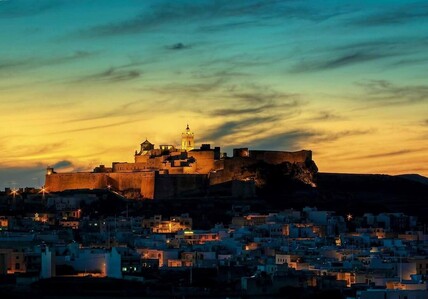 Mdina Anticipating the Turkish intentions, the governor of Mdina dressed the civilians in soldiers’ uniforms and had them patrol the ramparts along with the garrison. All available cannon was brought to the side to which the Turkish assault would approach. As the Muslims toiled up the long slopes to the city, they were shocked to see the walls bristling with cannon and armed men. As they came within range the cannon opened fire. The dismayed Turks halted and turned back: "It is another impregnable position! Another St. Elmo!" Depression in the Turkish Camps The Turks launched another attack on St. Angelo and St. Michael on 1 September, but their men were, by now, so drained and disheartened, reduced in numbers and enfeebled by fever and dysentery that the attack failed almost before it had begun. "It is not the will of Allah that we shall become masters of Malta." was the general consensus. The Long-Awaited Relief Force On 5 September, Viceroy Don Garcia set sail from Sicily with a relief force made up of professional soldiers from all over Europe, including many Italians, Germans, French and other European volunteers. The relief consisted of 10,000 fighting men in 28 ships. When news of the relief arrived on 8 September, Mustapha’s army was on the verge of mutiny. The Turkish fleet had lost the will to fight and did not even attempt to contest the landing. 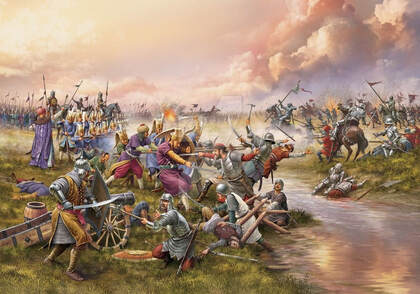 Reversal of Fortunes As the invaders began to embark, Mustapha learned that the relief force was actually smaller than his army, so he ordered his men back ashore. The relief force charged the Muslims and in a fierce battle slaughtered 3,000 of Mustapha's army, driving the remainder to sea. Valette rushed light cannon up to St. Elmo and fired upon the retreating fleet. The day the Muslims fled Malta was 11 September. Victory! The bells of the churches rang out over the shattered houses of Birgu and the victors sang Te Deum to the God who grants Victories. Nearly 250 Knights of the Order of St. John had lost their lives in the great siege. The survivors were all wounded, many crippled for life. Of the original 9,000 garrison, barely 600 were still capable of fighting. The Turks had lost over 30,000 men. Defeat! The Sultan, Suleiman, was devastated when he heard of this defeat: "Next year, I myself, the Sultan Suleiman, will lead an expedition against this accursed island. I will not spare one single inhabitant!" The following year, before he could carry out this threat, Suleiman died at age 72. At the beginning of his reign he had been defeated before the walls of Vienna, 1529. Now at the end of his reign, his army had suffered the most humiliating and decisive defeat at Malta. 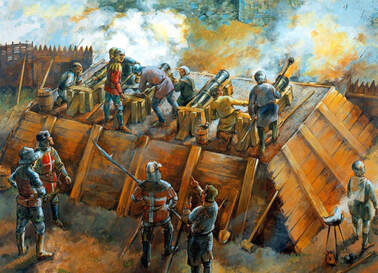 Decisive The Ottoman Turks never attempted to besiege Malta again. The failure of the siege denied Turkish forces control of Western Mediterranean and prevented their plans to conquer Southern Europe. The Great Siege of Malta was one of the most decisive victories in military history, changing the course of history and preventing the Western expansion of Turkish power. Celebrations All Europe rejoiced in celebrating the victory and in Malta, the church bells rang out triumphantly. Honours were showered upon the Grand Master La Valette by all the kingdoms of Europe and at last the Knights of St. John received the generous financial contributions that they needed to rebuild the ruined cities and fortresses of Malta. Italian Engineer, Francesco Zaparelli helped plan a magnificent citadel to be called Valette, named after the hero of the siege of Malta. Valette is built on Mount Sciberras, including the site of Fort St. Elmo. The Cathedral of St. John in Valette was described by Sir Walter Scott as: "The most magnificent church in all of Europe." Inspiring Example When he died, La Valette was buried in a great crypt in the Cathedral of St. John where the inscription reads: "Hear lies La Valette, the scourge of Africa and Asia, the shield of Europe, whence he expelled the barbarians by his holy arms…" The heroic defence of Malta against such overwhelming odds for over 4 months of relentless bombardment and assault inspired all of Europe to renewed efforts to defeat the Muslim menace. 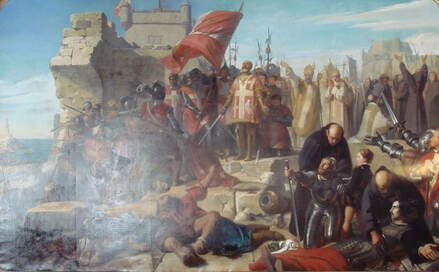 Victory Over Islam In 1571 the Turkish fleet was decisively annihilated at the Battle of Lepanto. The last great Turkish threat to the heart of Europe was defeated at the gates of Vienna on 11 September 1683. Malta Malta was one of the first nations in Europe to embrace Christianity, after the Apostle Paul’s shipwreck on the island. Malta has the highest church attendance of any country in Europe. Its area is a mere 316 km square, consisting of three small islands, with dry limestone hills and no rivers. The total population is just over 400,000. Malta received its independence from Britain in 1964 and has been a Parliamentary Republic since 1974. Malta entered the European Union in 2004. Malta celebrates the 8 September as a national holiday to mark the lifting of the Great Siege. "God is our refuge and strength, a very present help in trouble. Therefore we will not fear, even though the earth be removed, and though the mountains be carried into the midst of the sea; though its waters roar and be troubled, though the mountains shake with its swelling. There is a river whose streams make glad the city of God, the holy place of the Tabernacle of the Most High. God is in the midst of her, she shall not be moved; God shall help her, just at the break of dawn. The nations raged, the kingdoms were moved; He uttered His voice, the earth melted. The Lord of hosts is with us; the God of Jacob is our refuge." Psalm 46:1-7 Dr. Peter Hammond Reformation Society P.O. Box 74 Newlands 7725 Cape Town South Africa Tel: 021-689-4480 [email protected] www.ReformationSA.org www.HMSchoolofChristianJournalism.org The above presentation, as presented to the Reformation Society, is available on audio CD from: Christian Liberty Books, PO Box 358, Howard Place 7450, Cape Town, South Africa, Tel: 021-689-7478, Fax: 086-551-7490, Email: [email protected] and Website: www.christianlibertybooks.co.za. Bibliography:
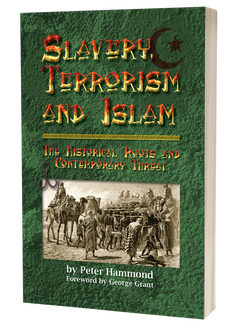 See also: The Islamisation of Europe and What Can Be Done to Stop and Reverse It The Armenian Genocide in Turkey - 100 Years Ago Why Should I Care About Dates in History? What is a Caliphate? Reformation or Islamisation? Slavery, Terrorism and Islam is also available as an E-Book
0 Comments
Leave a Reply. |
More Articles
All
Archives
July 2024
|
"And Jesus came and spoke to them, saying, “All authority has been given to Me in heaven and on earth.
Go therefore and make disciples of all the nations, baptizing them in the name of the Father and of the Son and of the Holy Spirit,
teaching them to observe all things that I have commanded you; and lo, I am with you always, even to the end of the age.” Amen.” Matthew 28: 18-20
Go therefore and make disciples of all the nations, baptizing them in the name of the Father and of the Son and of the Holy Spirit,
teaching them to observe all things that I have commanded you; and lo, I am with you always, even to the end of the age.” Amen.” Matthew 28: 18-20
|
P.O.Box 74 Newlands 7725
Cape Town South Africa |
|
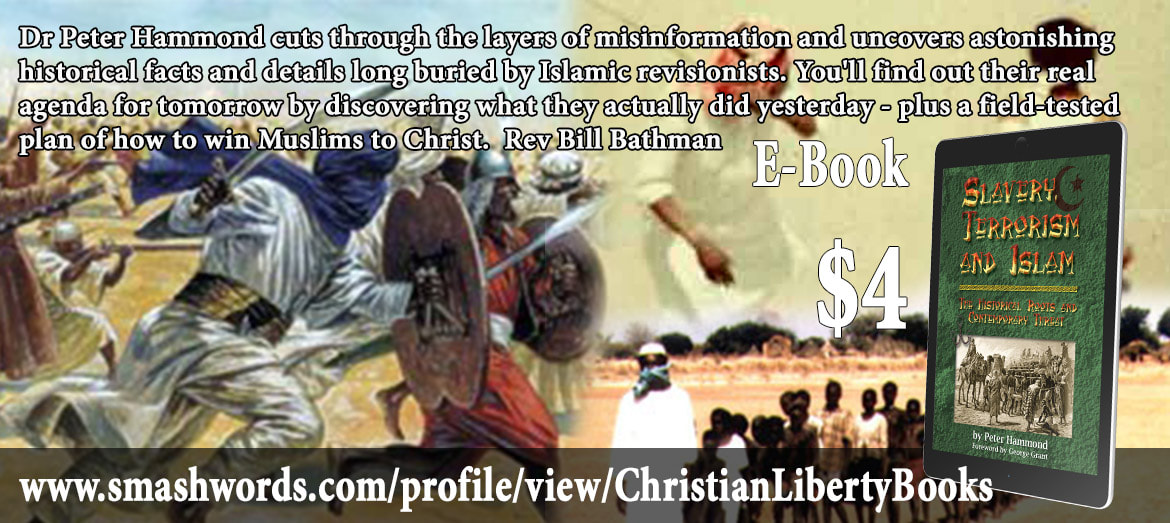
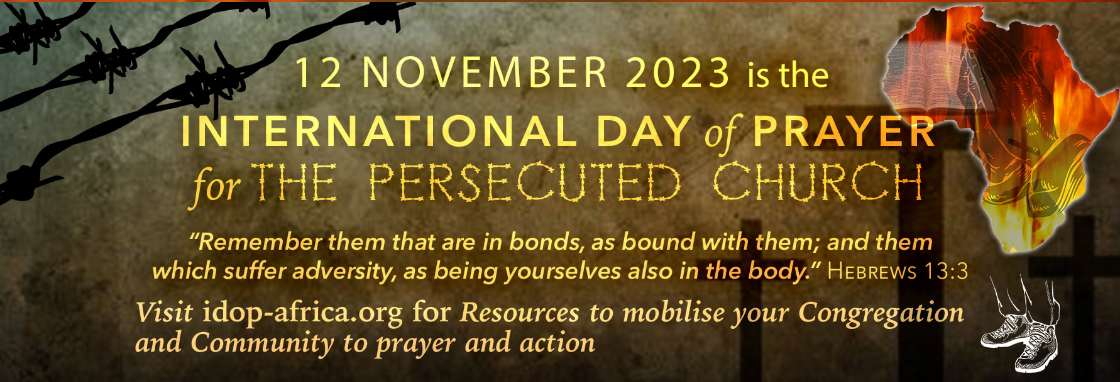
 RSS Feed
RSS Feed
